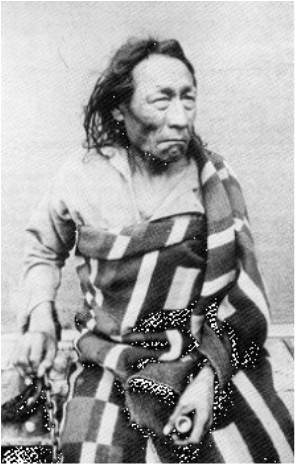When the Canadian government heard of this plan, they immediately disallowed it, even though the treaties had previously stated that the Natives could take the reserve land wherever they wished. To further his cause, Big Bear even formed an uneasy alliance with his longtime rivals. Despite his opposition to the treaty and his mistrust of the government’s intentions and methods, the dwindling of the buffalo herds ultimately prevented his people from continuing to rely on this traditional food source and pushed the Cree to the point of starvation in less than a decade. This desperate circumstance compelled Big Bear to finally accept Treaty 6 in order to obtain minimal food supplies for his people from the Canadian government.
During the North-West Rebellion of 1885, Big Bear and his supporters played a minimal role in the overall uprising, but warriors from among Big Bear's people under the command of another leader killed nine white men at Frog Lake in an incident that became known as the Frog Lake Massacre. Although Big Bear himself personally attempted to prevent the killings and subsequently expressed regret for the actions of the younger Cree warriors, the events at Frog Lake alarmed the Government. When 6,000 troops were sent to Batoche, Saskatchewan to smash the resistance, the Canadian government used the Frog Lake Massacre as a reason to put down the Cree as well. Despite evidence of Big Bear's efforts to actually prevent the killings at Frog Lake, he was convicted for participation in the rebellion with a request from the jury for mercy. In 1885 the sixty-year-old chief was sentenced to three years in Stony Mountain Penitentiary, but was released from prison before serving his complete sentence as a result of failing health, and died shortly afterward.
During the North-West Rebellion of 1885, Big Bear and his supporters played a minimal role in the overall uprising, but warriors from among Big Bear's people under the command of another leader killed nine white men at Frog Lake in an incident that became known as the Frog Lake Massacre. Although Big Bear himself personally attempted to prevent the killings and subsequently expressed regret for the actions of the younger Cree warriors, the events at Frog Lake alarmed the Government. When 6,000 troops were sent to Batoche, Saskatchewan to smash the resistance, the Canadian government used the Frog Lake Massacre as a reason to put down the Cree as well. Despite evidence of Big Bear's efforts to actually prevent the killings at Frog Lake, he was convicted for participation in the rebellion with a request from the jury for mercy. In 1885 the sixty-year-old chief was sentenced to three years in Stony Mountain Penitentiary, but was released from prison before serving his complete sentence as a result of failing health, and died shortly afterward.

